All Exams >
JEE >
35 Years Chapter wise Previous Year Solved Papers for JEE >
All Questions
All questions of Momentum and Impulse for JEE Exam
STATEMENT–1 : In an elastic collision between two bodies, the relative speed of the bodies after collision is equal to the relative speed before the collision. STATEMENT–2 : In an elastic collision, the linear momentum of the system is conserved.- a)Statement–1 is True, Statement–2 is True; Statement–2 is a correct explanation for Statement–1.
- b)Statement–1 is True, Statement–2 is True; Statement–2 is NOT a correct explanation for Statement–1
- c)Statement–1 is True, Statement–2 is False.
- d)Statement–1 is False, Statement–2 is True.
Correct answer is option 'D'. Can you explain this answer?
STATEMENT–1 : In an elastic collision between two bodies, the relative speed of the bodies after collision is equal to the relative speed before the collision.
STATEMENT–2 : In an elastic collision, the linear momentum of the system is conserved.
a)
Statement–1 is True, Statement–2 is True; Statement–2 is a correct explanation for Statement–1.
b)
Statement–1 is True, Statement–2 is True; Statement–2 is NOT a correct explanation for Statement–1
c)
Statement–1 is True, Statement–2 is False.
d)
Statement–1 is False, Statement–2 is True.

|
Jaideep Sengupta answered |
Statement 1 : For an elastic collision, the coefficient of restitution = 1

⇒ Relative velocity after collision is equal to relative velocity before collision. But in the statement relative speed is given.
Statement 2 : Linear momentum remains conserved in an elastic collision. This statement is true
Statement 2 : Linear momentum remains conserved in an elastic collision. This statement is true
Statement -1: Two particles moving in the same direction do not lose all their energy in a completely inelastic collision.
Statement -2 : Principle of conservation of momentum holds true for all kinds of collisions.- a)Statement -1 is true, Statement -2 is true ; Statement -2 is the correct explanation of Statement -1.
- b)Statement -1 is true, Statement -2 is true; Statement -2 is not the correct explanation of Statement -1
- c)Statement -1 is false, Statement -2 is true.
- d)Statement -1 is true, Statement -2 is false.
Correct answer is option 'A'. Can you explain this answer?
Statement -1: Two particles moving in the same direction do not lose all their energy in a completely inelastic collision.
Statement -2 : Principle of conservation of momentum holds true for all kinds of collisions.
Statement -2 : Principle of conservation of momentum holds true for all kinds of collisions.
a)
Statement -1 is true, Statement -2 is true ; Statement -2 is the correct explanation of Statement -1.
b)
Statement -1 is true, Statement -2 is true; Statement -2 is not the correct explanation of Statement -1
c)
Statement -1 is false, Statement -2 is true.
d)
Statement -1 is true, Statement -2 is false.

|
Jaideep Sengupta answered |
In completely inelastic collision, all energy is not lost (so, statement -1 is true) and the principle of conservation of momentum holds good for all kinds of collisions (so, statement -2 is true) . Statement -2 explains statement -1 correctly because applying the principle of conservation of momentum, we can get the common velocity and hence the kinetic energy of the combined body.
A point mass of 1 kg collides elastically with a stationary point mass of 5 kg. After their collision, the 1 kg mass reverses its direction and moves with a speed of 2 ms–1. Which of the following statement(s) is (are) correct for the system of these two masses?- a)Total momentum of the system is 3 kg ms–1
- b)Momentum of 5 kg mass after collision is 4 kg ms–1
- c)Kinetic energy of the centre of mass is 0.75 J
- d)Total kinetic energy of the system is 4J
Correct answer is option 'A,C'. Can you explain this answer?
A point mass of 1 kg collides elastically with a stationary point mass of 5 kg. After their collision, the 1 kg mass reverses its direction and moves with a speed of 2 ms–1. Which of the following statement(s) is (are) correct for the system of these two masses?
a)
Total momentum of the system is 3 kg ms–1
b)
Momentum of 5 kg mass after collision is 4 kg ms–1
c)
Kinetic energy of the centre of mass is 0.75 J
d)
Total kinetic energy of the system is 4J

|
Akash Shah answered |
According to law of conservation of linear momentum 1 × u1 + 5 × 0 = 1 (–2) + 5 (v2)
⇒ u1 = – 2 + 5 v2 ...(i)
⇒ u1 = – 2 + 5 v2 ...(i)
The coefficient of restituition

On solving (i) & (ii) we get desired results.
A mass ‘m’ moves with a velocity ‘v’ and collides inelastically with another identical mass . After collision the 1st mass moves with velocity  in a direction perpendicular to the initial direction of motion. Find the speed of the 2nd mass after collision.
in a direction perpendicular to the initial direction of motion. Find the speed of the 2nd mass after collision.
- a)

- b)v
- c)

- d)

Correct answer is option 'D'. Can you explain this answer?
A mass ‘m’ moves with a velocity ‘v’ and collides inelastically with another identical mass . After collision the 1st mass moves with velocity  in a direction perpendicular to the initial direction of motion. Find the speed of the 2nd mass after collision.
in a direction perpendicular to the initial direction of motion. Find the speed of the 2nd mass after collision.
 in a direction perpendicular to the initial direction of motion. Find the speed of the 2nd mass after collision.
in a direction perpendicular to the initial direction of motion. Find the speed of the 2nd mass after collision.
a)

b)
v
c)

d)

|
|
Arup Pura answered |
Option (D) is the correct answer.
Here is the explanation :
Initial momentum of the particles = mv +0 = mv
which is along x-axis.
After collision the net momentum of the system should also be equal to mv and along x-axis only
Thus,
the 2nd particle should have two velocities, one equal to v/(root 3) opposite to the velocity of first particle after collision
And other velocity equal to v along x axis
Thus net speed of 2nd particle after collision is equal to magnitude of [ v/(root 3)j + v i]
Which is equal to 2v/(root3)
Here is the explanation :
Initial momentum of the particles = mv +0 = mv
which is along x-axis.
After collision the net momentum of the system should also be equal to mv and along x-axis only
Thus,
the 2nd particle should have two velocities, one equal to v/(root 3) opposite to the velocity of first particle after collision
And other velocity equal to v along x axis
Thus net speed of 2nd particle after collision is equal to magnitude of [ v/(root 3)j + v i]
Which is equal to 2v/(root3)
The figure shows the position–time (x – t) graph of onedimensional motion of a body of mass 0.4 kg. The magnitude of each impulse is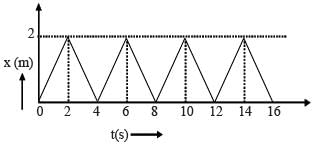
- a)0.4 Ns
- b)0.8 Ns
- c)1.6 Ns
- d)0.2 Ns
Correct answer is option 'B'. Can you explain this answer?
The figure shows the position–time (x – t) graph of onedimensional motion of a body of mass 0.4 kg. The magnitude of each impulse is

a)
0.4 Ns
b)
0.8 Ns
c)
1.6 Ns
d)
0.2 Ns

|
Milan Roy answered |
During each collision

Impulse = Change in momentum

A particle of mass m is projected from the ground with an initial speed u0 at an angle α with the horizontal. At the highest point of its trajectory, it makes a completely inelastic collision with another identical particle, which was thrown vertically upward from the ground with the same initial speed u0. The angle that the composite system makes with the horizontal immediately after the collision is- a)

- b)

- c)

- d)

Correct answer is option 'A'. Can you explain this answer?
A particle of mass m is projected from the ground with an initial speed u0 at an angle α with the horizontal. At the highest point of its trajectory, it makes a completely inelastic collision with another identical particle, which was thrown vertically upward from the ground with the same initial speed u0. The angle that the composite system makes with the horizontal immediately after the collision is
a)

b)

c)

d)


|
Devika Banerjee answered |
Activity B to M for particle thrown upwards
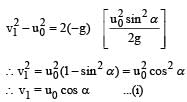
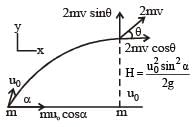
Applying conservation of linear momentum in Y-direction
2mv sinθ = mv1 = mu0cosα ...(ii) [from (i)]
Applying conservation of linear momentum in X-direction
2mv cosθ = mu0 cosα ...(iii)
on dividing (ii) and (iii) we get

Two blocks A and B, each of mass m, are connected by a massless spring of natural length L and spring constant K.
The blocks are initially resting on a smooth horizontal floor with the spring at its natural length, as shown in fig.. A third identical block C, also of mass m, moves on the floor with a speed v along the line joining A and B, and collides elastically with A. Then
- a)the kinetic energy of the A-B system, at maximum compression of the spring, is zero.
- b)the kinetic energy of the A-B system, at maximum compression of the spring, is mv2/4.
- c)the maximum compression of the spring is

- d)the maximum compression of the spring is

Correct answer is option 'B,D'. Can you explain this answer?
Two blocks A and B, each of mass m, are connected by a massless spring of natural length L and spring constant K.
The blocks are initially resting on a smooth horizontal floor with the spring at its natural length, as shown in fig.. A third identical block C, also of mass m, moves on the floor with a speed v along the line joining A and B, and collides elastically with A. Then
The blocks are initially resting on a smooth horizontal floor with the spring at its natural length, as shown in fig.. A third identical block C, also of mass m, moves on the floor with a speed v along the line joining A and B, and collides elastically with A. Then

a)
the kinetic energy of the A-B system, at maximum compression of the spring, is zero.
b)
the kinetic energy of the A-B system, at maximum compression of the spring, is mv2/4.
c)
the maximum compression of the spring is 

d)
the maximum compression of the spring is 


|
Ritika Kulkarni answered |
In situation 1, mass C is moving towards right with velocity v. A and B are at rest.
In situation 2, which is just after the collision of C with A, C stop and A acquires a velocity v. [head-on elastic collision between identical masses]
When A starts moving towards right, the spring suffer a compression due to which B also starts moving towards right. The compression of the spring continues till there is relative velocity between A and B. When this relative velocity becomes zero, both A and B move with the same velocity v' and the spring is in a state of maximum compression.
Applying momentum conservation in situation 1 and 3,
In situation 2, which is just after the collision of C with A, C stop and A acquires a velocity v. [head-on elastic collision between identical masses]
When A starts moving towards right, the spring suffer a compression due to which B also starts moving towards right. The compression of the spring continues till there is relative velocity between A and B. When this relative velocity becomes zero, both A and B move with the same velocity v' and the spring is in a state of maximum compression.
Applying momentum conservation in situation 1 and 3,



∴ K.E. of the system in situation 3 is

This is the kinetic energy possessed by A – B system (since, C is at rest).
Let x be the maximum compression of the spring.
Applying energy conservation
Let x be the maximum compression of the spring.
Applying energy conservation
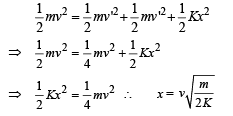
The balls, having linear momenta  undergo a collision in free space. There is no external force acting on the balls. Let
undergo a collision in free space. There is no external force acting on the balls. Let  be their final momenta. The following option (s) is (are) NOT ALLOWED for any non-zero value of p, a1, a2, b1, b2, c1 and c2.
be their final momenta. The following option (s) is (are) NOT ALLOWED for any non-zero value of p, a1, a2, b1, b2, c1 and c2.- a)

- b)

- c)

- d)

Correct answer is option 'A,D'. Can you explain this answer?
The balls, having linear momenta  undergo a collision in free space. There is no external force acting on the balls. Let
undergo a collision in free space. There is no external force acting on the balls. Let  be their final momenta. The following option (s) is (are) NOT ALLOWED for any non-zero value of p, a1, a2, b1, b2, c1 and c2.
be their final momenta. The following option (s) is (are) NOT ALLOWED for any non-zero value of p, a1, a2, b1, b2, c1 and c2.
 undergo a collision in free space. There is no external force acting on the balls. Let
undergo a collision in free space. There is no external force acting on the balls. Let  be their final momenta. The following option (s) is (are) NOT ALLOWED for any non-zero value of p, a1, a2, b1, b2, c1 and c2.
be their final momenta. The following option (s) is (are) NOT ALLOWED for any non-zero value of p, a1, a2, b1, b2, c1 and c2.a)

b)

c)

d)


|
Rounak Desai answered |
KEY CONCEPT Use law of conservation of linear momentum.
The initial linear momentum of the system is Therefore the final linear momentum should also be zero.
Therefore the final linear momentum should also be zero.
Option a :
 Final momentum.
Final momentum.
It is given that a1, b1, c1, a2, b2 and c2 have non-zero values. If a1 = x and a2 = – x. Also if b1 = y and b2 = – y then the components become zero. But the third term having
components become zero. But the third term having  component is non-zero. This gives a definite final momentum to the system which violates conservation of linear momentum, so this is an incorrect option.
component is non-zero. This gives a definite final momentum to the system which violates conservation of linear momentum, so this is an incorrect option.
The initial linear momentum of the system is
 Therefore the final linear momentum should also be zero.
Therefore the final linear momentum should also be zero.Option a :
 Final momentum.
Final momentum.It is given that a1, b1, c1, a2, b2 and c2 have non-zero values. If a1 = x and a2 = – x. Also if b1 = y and b2 = – y then the
 components become zero. But the third term having
components become zero. But the third term having  component is non-zero. This gives a definite final momentum to the system which violates conservation of linear momentum, so this is an incorrect option.
component is non-zero. This gives a definite final momentum to the system which violates conservation of linear momentum, so this is an incorrect option.Option d:
 because b1 ≠ 0
because b1 ≠ 0Following the same reasoning as above this option is also ruled ou
A particle of mass m is attached to one end of a mass-less spring of force constant k, lying on a frictionless horizontal plane. The other end of the spring is fixed. The particle starts moving horizontally from its equilibrium position at time t = 0 with an initial velocity u0. When the speed of the particle is 0.5 u0, it collides elastically with a rigid wall. After this collision- a)The speed of the particle when it returns to its equilibrium position is u0
- b)The time at which the particle passes through the equilibrium position for the first time is

- c)The time at which the maximum compression of the spring occurs is

- d)The time at which the particle passes through the equilibrium position for the second time is

Correct answer is option 'A,D'. Can you explain this answer?
A particle of mass m is attached to one end of a mass-less spring of force constant k, lying on a frictionless horizontal plane. The other end of the spring is fixed. The particle starts moving horizontally from its equilibrium position at time t = 0 with an initial velocity u0. When the speed of the particle is 0.5 u0, it collides elastically with a rigid wall. After this collision
a)
The speed of the particle when it returns to its equilibrium position is u0
b)
The time at which the particle passes through the equilibrium position for the first time is 

c)
The time at which the maximum compression of the spring occurs is 

d)
The time at which the particle passes through the equilibrium position for the second time is 


|
Athira Datta answered |
The particle collides elastically with rigid wall. Here

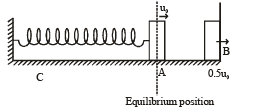
i.e. the particle rebounds with the same speed. Therefore the particle will return to its equilibrium position with speed u0. option (a) is correct.
The velocity of the particle becomes 0.5u0 after time t.
Then using the equation V = Vmax cos wt we get 0.5u0 = u0 cos wt

The time period
The time taken by the particle to pass through the equilibrium for the first time Therefore option (b) is incorrect
Therefore option (b) is incorrect
The time taken for the maximum compression
The velocity of the particle becomes 0.5u0 after time t.
Then using the equation V = Vmax cos wt we get 0.5u0 = u0 cos wt

The time period

The time taken by the particle to pass through the equilibrium for the first time
 Therefore option (b) is incorrect
Therefore option (b) is incorrectThe time taken for the maximum compression

 Therefore option c is incorrect.
Therefore option c is incorrect.The time taken for particle to pass through the equilibrium position second time

option (d) is correct.
A bomb of mass 16kg at rest explodes into two pieces of masses 4 kg and 12 kg. The velolcity of the 12 kg mass is 4 ms–1. The kinetic energy of the other mass is- a)144 J
- b)288 J
- c)192 J
- d)96 J
Correct answer is option 'B'. Can you explain this answer?
A bomb of mass 16kg at rest explodes into two pieces of masses 4 kg and 12 kg. The velolcity of the 12 kg mass is 4 ms–1. The kinetic energy of the other mass is
a)
144 J
b)
288 J
c)
192 J
d)
96 J

|
Devansh Joshi answered |
Let the velocity and mass of 4 kg piece be v1 and m1 and that of 12 kg piece be v2 and m2
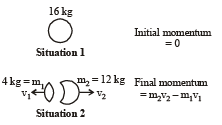
Applying conservation of linear momentum

This question has statement I and statement II. Of the four choices given after the statements, choose the one that best describes the two statements.Statement - I: Apoint particle of mass m moving with speed  with stationary point particle of mass M. If the maximum energy loss possible is given as
with stationary point particle of mass M. If the maximum energy loss possible is given as  then
then  Statement - II: Maximum energy loss occurs when the particles get stuck together as a result of the collision.
Statement - II: Maximum energy loss occurs when the particles get stuck together as a result of the collision.- a)Statement - I is true, Statment - II is true, Statement - II is the correct explanation of Statement - I.
- b)Statement-I is true, Statment - II is true, Statement - II is not the correct explanation of Statement - II.
- c)Statement - I is true, Statment - II is false.
- d)Statement - I is false, Statment - II is true.
Correct answer is option 'D'. Can you explain this answer?
This question has statement I and statement II. Of the four choices given after the statements, choose the one that best describes the two statements.
Statement - I: Apoint particle of mass m moving with speed  with stationary point particle of mass M. If the maximum energy loss possible is given as
with stationary point particle of mass M. If the maximum energy loss possible is given as  then
then 
 with stationary point particle of mass M. If the maximum energy loss possible is given as
with stationary point particle of mass M. If the maximum energy loss possible is given as  then
then 
Statement - II: Maximum energy loss occurs when the particles get stuck together as a result of the collision.
a)
Statement - I is true, Statment - II is true, Statement - II is the correct explanation of Statement - I.
b)
Statement-I is true, Statment - II is true, Statement - II is not the correct explanation of Statement - II.
c)
Statement - I is true, Statment - II is false.
d)
Statement - I is false, Statment - II is true.

|
Mira Roy answered |



Statement II is a case of perfectly inelastic collision.
By comparing the equation given in statement I with above equation, we get

Hence statement I is wrong and statement II is correct.
Two particles of masses m1 and m2 in projectile motion have velocities  respectively at time t = 0. They collide at time to. Their velocities become
respectively at time t = 0. They collide at time to. Their velocities become  at time 2to while still moving in air. The value of
at time 2to while still moving in air. The value of 
- a)zero
- b)

- c)

- d)

Correct answer is option 'D'. Can you explain this answer?
Two particles of masses m1 and m2 in projectile motion have velocities  respectively at time t = 0. They collide at time to. Their velocities become
respectively at time t = 0. They collide at time to. Their velocities become  at time 2t
at time 2t
 respectively at time t = 0. They collide at time to. Their velocities become
respectively at time t = 0. They collide at time to. Their velocities become  at time 2t
at time 2to
while still moving in air. The value of 
a)
zero
b)

c)

d)


|
Athira Datta answered |
If we consider the two particles as a system then the external force acting on the system is the gravitational pull (m1 + m2) g.


A ball of mass 0.2 kg rests on a vertical post of height 5 m. A bullet of mass 0.01 kg, traveling with a velocity V m/s in a horizontal direction, hits the centre of the ball. After the collision, the ball and bullet travel independently. The ball hits the ground at a distance of 20 m and the bullet at a distance of 100 m from the foot of the post. The velocity V of the bullet is
- a)250 m/s
- b)250√2 m/s
- c)400 m/s
- d)500 m/s
Correct answer is option 'D'. Can you explain this answer?
A ball of mass 0.2 kg rests on a vertical post of height 5 m. A bullet of mass 0.01 kg, traveling with a velocity V m/s in a horizontal direction, hits the centre of the ball. After the collision, the ball and bullet travel independently. The ball hits the ground at a distance of 20 m and the bullet at a distance of 100 m from the foot of the post. The velocity V of the bullet is

a)
250 m/s
b)
250√2 m/s
c)
400 m/s
d)
500 m/s

|
Rounak Desai answered |
For vertical motion of bullet or ball
u = 0, s = 5m, t = ? , a = 10m/s2
u = 0, s = 5m, t = ? , a = 10m/s2
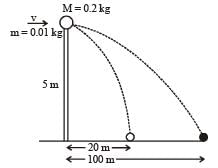

For horizontal motion of ball

For horizontal motion of bullet

Applying conservation of linear momentum during collision, w e get

Two blocks of masses 10 kg and 4 kg are connected by a spring of negligible mass and placed on a frictionless horizontal surface. An impulse gives a velocity of 14 m/s to the heavier block in the direction of the lighter block. The velocity of the centre of mass is- a)30 m/s
- b)20 m/s
- c)10 m/s
- d)5 m/s
Correct answer is option 'C'. Can you explain this answer?
Two blocks of masses 10 kg and 4 kg are connected by a spring of negligible mass and placed on a frictionless horizontal surface. An impulse gives a velocity of 14 m/s to the heavier block in the direction of the lighter block. The velocity of the centre of mass is
a)
30 m/s
b)
20 m/s
c)
10 m/s
d)
5 m/s

|
Avi Chawla answered |
Just after collision

Note : Spring force is an internal force, it cannot change the linear momentum of the (two mass + spring) system.
Therefore vc remains the same.
Therefore vc remains the same.
A machine gun fires a bullet of mass 40 g with a velocity 1200 ms–1. The man holding it can exert a maximum force of 144 N on the gun. How many bullets can he fire per second at the most?- a)Two
- b)Four
- c)One
- d)Three
Correct answer is option 'D'. Can you explain this answer?
A machine gun fires a bullet of mass 40 g with a velocity 1200 ms–1. The man holding it can exert a maximum force of 144 N on the gun. How many bullets can he fire per second at the most?
a)
Two
b)
Four
c)
One
d)
Three

|
Milan Roy answered |
Let n be the number of bullets that the man can fire in one second.
∴ change in momentum per second = n x mv = F
[m = mass of bullet, v = velocity] (∵ F is the force)
∴ change in momentum per second = n x mv = F
[m = mass of bullet, v = velocity] (∵ F is the force)

A ball hits the floor and rebounds after an inelastic collision. In this case- a)the momentum of the ball just after the collision is the same as that just before the collision.
- b)the mechanical energy of the ball remains the same in the collision
- c)the total momen tum of the ball and the earth is conserved
- d)the total energy of the ball and the earth is conserved
Correct answer is option 'C,D'. Can you explain this answer?
A ball hits the floor and rebounds after an inelastic collision. In this case
a)
the momentum of the ball just after the collision is the same as that just before the collision.
b)
the mechanical energy of the ball remains the same in the collision
c)
the total momen tum of the ball and the earth is conserved
d)
the total energy of the ball and the earth is conserved

|
Devika Banerjee answered |
(a) is wrong because the momentum of ball changes in magnitude as well as direction.
(b) is wrong because on collision, some mechanical energy is converted into heat, sound energy.
(b) is wrong because on collision, some mechanical energy is converted into heat, sound energy.
(c) is correct because for earth + ball system the impact force is an internal force.
(d) is correct.
(d) is correct.
A shell is fired from a cannon with a velocity v (m/sec.) at an angle θ with the horizontal direction. At the highest point in its path it explodes into two pieces of equal mass. One of the pieces retraces its path to the cannon and the speed (in m/sec.) of the other piece immediately after the explosion is- a)3v cos θ
- b)2v cos θ
- c)

- d)

Correct answer is option 'A'. Can you explain this answer?
A shell is fired from a cannon with a velocity v (m/sec.) at an angle θ with the horizontal direction. At the highest point in its path it explodes into two pieces of equal mass. One of the pieces retraces its path to the cannon and the speed (in m/sec.) of the other piece immediately after the explosion is
a)
3v cos θ
b)
2v cos θ
c)

d)


|
Lekshmi Bose answered |
As one piece retraces its path, the speed of this piece just after explosion should be v cos θ

(At highest point just after explosion) NOTE THIS STEP
Applying conservation of linear momentum at the highest point;
Applying conservation of linear momentum at the highest point;

A particle of mass m moving in the x direction with speed 2v is hit by another particle of mass 2m moving in the y direction with speed v. If the collision is perfectly inelastic, the percentage loss in the energy during the collision is close to :- a)56%
- b)62%
- c)44%
- d)50%
Correct answer is option 'A'. Can you explain this answer?
A particle of mass m moving in the x direction with speed 2v is hit by another particle of mass 2m moving in the y direction with speed v. If the collision is perfectly inelastic, the percentage loss in the energy during the collision is close to :
a)
56%
b)
62%
c)
44%
d)
50%

|
Devansh Joshi answered |
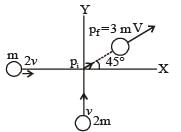
Initial momentum of the system

Final momentum of the system = 3mV By the law of conservation of momentum


Percentage loss in energy during the collision = 56%
Chapter doubts & questions for Momentum and Impulse - 35 Years Chapter wise Previous Year Solved Papers for JEE 2025 is part of JEE exam preparation. The chapters have been prepared according to the JEE exam syllabus. The Chapter doubts & questions, notes, tests & MCQs are made for JEE 2025 Exam. Find important definitions, questions, notes, meanings, examples, exercises, MCQs and online tests here.
Chapter doubts & questions of Momentum and Impulse - 35 Years Chapter wise Previous Year Solved Papers for JEE in English & Hindi are available as part of JEE exam.
Download more important topics, notes, lectures and mock test series for JEE Exam by signing up for free.

Contact Support
Our team is online on weekdays between 10 AM - 7 PM
Typical reply within 3 hours
|
Free Exam Preparation
at your Fingertips!
Access Free Study Material - Test Series, Structured Courses, Free Videos & Study Notes and Prepare for Your Exam With Ease

 Join the 10M+ students on EduRev
Join the 10M+ students on EduRev
|

|
Create your account for free
OR
Forgot Password
OR
Signup to see your scores
go up
within 7 days!
within 7 days!
Takes less than 10 seconds to signup









